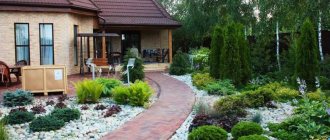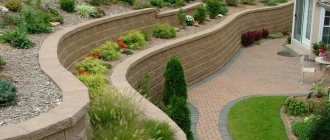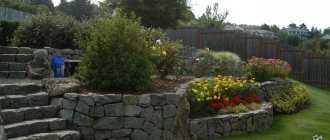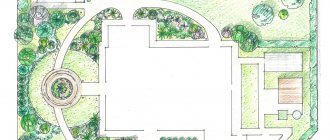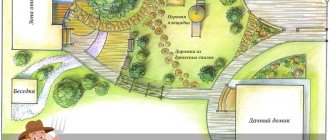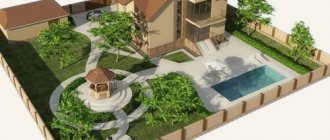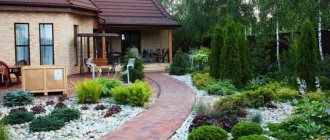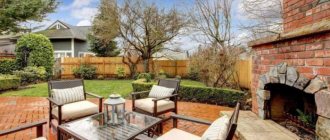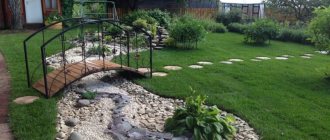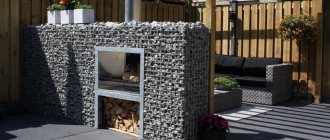Features of hilly areas
If you look at the photos of the plots on the slope, you will notice that they have a special layout, as well as a design.
The design of each such plot requires a special approach, since it is necessary to take into account the specificity of the soil, the angle of elevation, and the features of the relief. Work on landscape design is more voluminous and more difficult than on level ground, as it requires additional efforts to strengthen the soil.
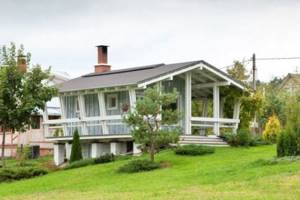
Even if there is no need for design, but you just need a vegetable garden or garden, then you need to approach the planning responsibly. This is justified by the fact that over time the soil may “move” under the weight of buildings and plantings.
Floristry concept
A plot on a slope is an ideal place to create a landscape with a mountain landscape. Location relative to the cardinal points plays an important role in this matter. The northern slope is in an advantageous position. Moisture-loving plants that fully develop in the shade will take root here. It is preferable to decorate the slope area on the south side with flora accustomed to high temperatures and lack of moisture.
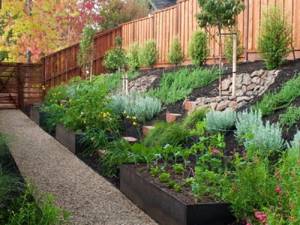
Advice! An important condition is the flowering period. Plants are selected in such a way that the slopes of the site remain attractive throughout the warm season.
Suitable for spring:
- crocuses;
- daffodils;
- hyacinths;
- tulips.
In summer, the plot can be registered:
- primrose;
- marigolds;
- peonies;
- delphinium;
- irises;
- lilies;
- gladioli.
It is difficult to imagine an autumn landscape without dahlias, asters, and chrysanthemums. The choice of flowers largely depends on the region where the site is located and the characteristics of the soil. It is possible to make caring for flower beds easier if you decorate them with perennial plants.
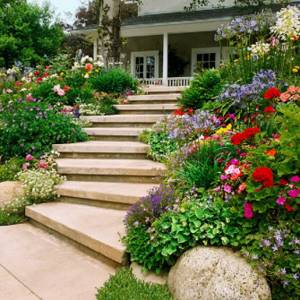
The concept of planting trees and shrubs is largely determined by the location of the house on a site with a slope. Usually housing is located at the highest point. Trees should not cover the structure; it is better to surround it with ornamental shrubs. Boxwood, juniper and magnolia will help add sophistication to the landscape.
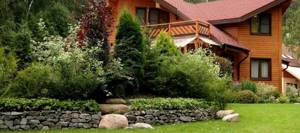
If there are financial opportunities, the territory is decorated with waterfalls or a pond is created below.
Following the recommendations on how to design country properties with a slope will help create a unique landscape design that will delight the eye for a long period.
Recommended Posts
Functional zoning of the
Clinker plot on a cottage plot
How to make a flowerbed from stones + photo
Flower beds and flower beds at the dacha
Perennial flower beds + photos
Ampelous plants in the garden landscape
Design ideas
Before developing the design of a site on a slope, it is necessary to inspect it from a functionality point of view and choose a method for strengthening the soil.

One of the most popular design options for a site on a slope is terracing. The ledges can be of different sizes, shapes, located symmetrically or chaotically. The appearance of each terrace and its decoration depends only on the owner’s idea. The ledges are connected by paths or steps.
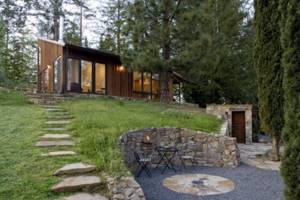
On the terraces you can organize a vegetable garden, a garden, recreation areas, and outbuildings. A stream can run from the upper platform to the lower one. It is recommended to decorate the edges of the steps with floristry or use stones, logs, fences, etc.
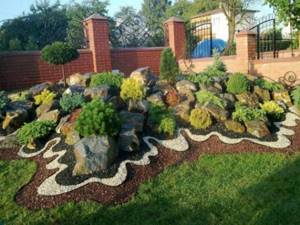
The slope can be left unchanged (if no plantings or buildings are planned on it), strengthening the soil. Such plots can become a place for a walk.
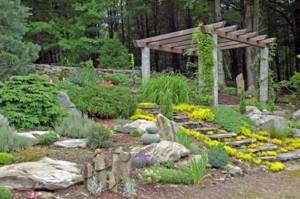
Recommendations for the design of paths, stairs and lighting
It is impossible to imagine the landscape design of a site on a slope without landscaped paths. In addition to the practical function of ensuring comfortable movement, they successfully cope with the task of connecting terraces together into a single harmonious picture. In order for the decorated path to create a single ensemble with the fortifications of the slope, it is recommended to make it from the same material as the terrace.
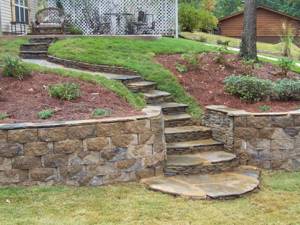
A vivid perception of a clear picture is possible if you decorate the paths with large elements, be it natural stone or tree cuts. There are also nuances when choosing a shape: winding lines artificially hide the steepness of the slope, serpentine emphasizes the peculiarity of a site with a slope.
Shrubs and low trees will help you admire the landscape if you plant them in the bends of paths. To safely use a path with a steep slope, you will definitely need a ladder. Its width must correspond to the width of the path and be at least 0.6 m. The number of steps on the stairs depends on the steepness of the slope on the site.
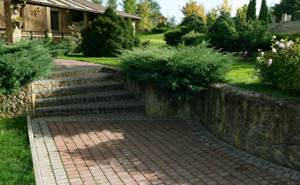
Designers suggest dividing a large number of steps with a platform. It is advisable that it be located at the bend of the path. If the area is of sufficient size, it is recommended to decorate it with a bench. A decorative flowerpot or an elegant statue will effectively complement the landscape design of a slope. It is preferable to make a staircase in a shady area from light-colored building materials.
Important! The beauty of the landscape should not interfere with the safety of movement around the site. Paths and stairs must be made of material that does not slip after getting wet.
If the stair step has an inconvenient height for climbing, it is better to design the structure with railings.
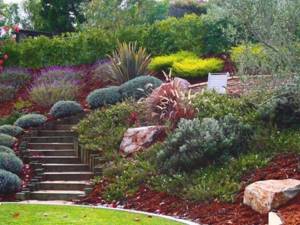
Lighting remains an important element of site design. Turning on the lights in the evening not only contributes to comfortable movement along the slope, but also creates a unique romantic atmosphere. It is quite difficult to design a lighting system for a large area with your own hands. It is better to invite a specialist to draw up a project, which is translated into reality at the stage of arrangement of the slopes.
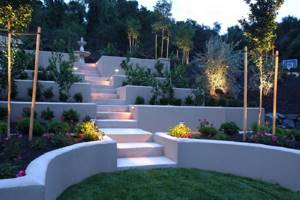
Strengthening with geomaterial
If the elevation degree exceeds 30, then it is recommended to strengthen the soil with geotextiles or geogrids. They are placed on the surface, covered with soil, and after a while they are planted with small plants.
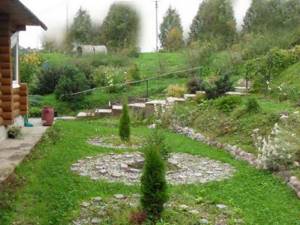
It will not be possible to place something more significant (buildings, garden) in such a place, but the soil will not “move.” The landscape design of the site on a slope will make this place ideal for relaxation.

Stairs and landings
It is difficult to imagine an aesthetic landscape design of a site on a slope without staircases and recreation areas.
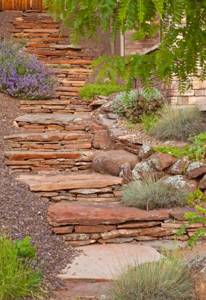
They make it possible to increase the decorative design of the territory, with the most useful use of free space and the arrangement of recreation areas between the terraces on the site.
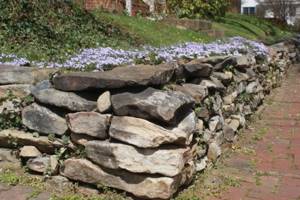
Stone retaining walls are options for constructing and arranging areas with a slope. 115 photos of landscape design ideas
How to arrange a summer cottage - design options, beautiful ideas and stylish design solutions (90 photos + video)
- How to make a well with your own hands - design ideas and recommendations on how to beautifully design a well (110 photos + video)
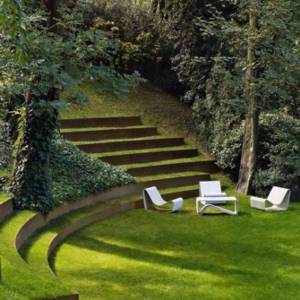
Drainage system
The layout of a site on a slope should take into account such features as the accumulation of moisture in the lowlands and the erosion of supporting walls. To avoid such troubles, you need to think through the drainage system in advance. Landscape designers prefer open structures. They are made in the form of streams, decorative gutters, and water slides.

There are drainage systems made from water-conducting layers or complex drainage systems with filtration. Any design and soil strengthening option, as well as creative ideas, can make a non-prestigious plot on a slope a beautiful and comfortable place to live and relax.
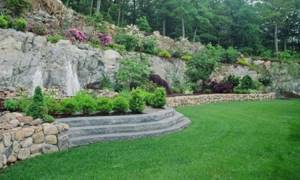
Arrangement of the drainage system
Spring floods and seasonal rainfall are serious enemies of sloped areas. The most reliable option to solve the problem of soil erosion and damage to the integrity of the terrace structure is to install a drainage system on the site.
There are several ways to arrange a drainage system. Sites with slight slopes usually have simple drainage. To do this, at the stage of strengthening the slope, the presence of layers that allow moisture to pass through well is provided. They include:
- coarse sand;
- fine gravel;
- broken bricks and other materials.
It is preferable to design a site with a steep slope with a complex system, which provides for the presence of plastic drainage pipes and filtration holes. At the stage of arranging drainage, it is recommended to simultaneously design an irrigation system.
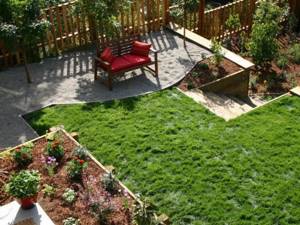
Designed drainage systems are of open and closed type. In the first case, the decorative component of landscape design comes to the fore, while the second method saves space. The water flowing down the gutters can be transformed into a picturesque waterfall, and at the bottom you can create an artificial pond.
Advice! The design is practical when the drainage system is combined with a water storage tank. In the future, it is used for automatic watering of the site.
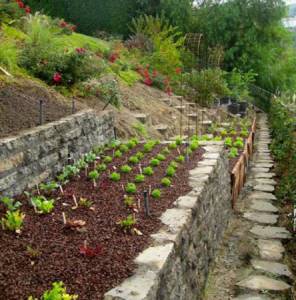
Design
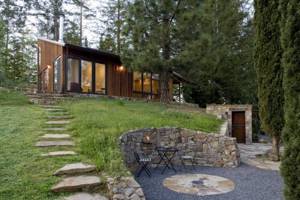
The disadvantages of a multi-level village site create certain difficulties when developing landscape design on an elephant. On the other hand, non-standard terrain allows you to implement original ideas, make an alpine slide or a beautiful waterfall with a stream going down the steps, which is created through terracing.
Multi-level terraced areas of the garden with plants near the house make it possible to naturally distinguish between flower beds and flower beds. The presence of a staircase in the garden allows you to play up the ceremonial classical style of design on a plot with a slope. And the possibility of arranging a small artificial pond is suitable for landscape design of a garden on a slope in the Japanese style.
Stairs
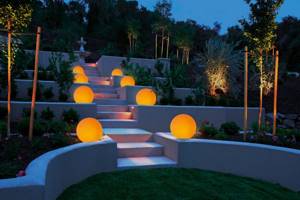
Stairs on a multi-level terraced area are an integral part of the garden landscape design. Steps made of stone or paving slabs serve not only to decorate the landscape, but also to strengthen the walls of the slope of a village site. For slight slopes, wooden steps are used.
It is important that the stairs on the site are landscaped in the same style and are in harmony with each other.
Serpentines emphasize the steepness of the slope, strengthened by retaining walls. Steps should be comfortable and safe. If the structure is too steep, it is recommended to add railings and consider night lighting.
Paths
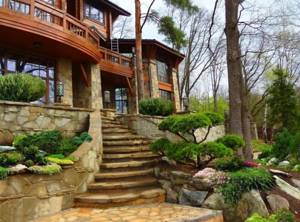
The paths on the site with a slope alternate with terraced stairs. It is worth choosing a single design style for steps and paths . Stone or concrete slabs and wooden boards are suitable for designing paths. To improve the area along the paths, you can arrange natural borders; for this, lavender flowers or other low plants and shrubs are planted.
Beautiful paths on the slope can be paved with multi-colored pebbles or made with a mosaic made of artificial stone. Along the paths, small stone or concrete chips are usually used to decorate the garden.
landscaping
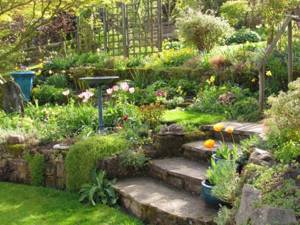
To plant landscaping on a slope reinforced with retaining walls, the idea of an alpine hill and landscape design reminiscent of a mountainous area are used. When choosing plants for a garden on a slope, several factors should be taken into account:
- The direction of the world and the illumination of the slope wall;
- Distribution of water on the site;
- Soil features.
In order for bright flowers to decorate the slope of the site all summer, it is worth choosing plants with different flowering periods. Plants are planted on a slope according to the design principle of an alpine hill, tall at the top, preference is given to coniferous shrubs, at the bottom low, for example, mosses, magnolias, dwarf carnations. The best location for heat-loving plants, shrubs and a vegetable garden with beds is the southern slope of the site.
Features of laying paving stones on slopes
This article indicates the features of laying paving stones on slopes with shallow and medium slopes. In areas with a steep slope, paving stones are used as decoration for supporting walls or as a facing material for staircase steps.
Slight steepness
Areas with a shallow slope (3-8) appear as a result of the natural topography of the territory. They are typical for blind areas of residential buildings or personal plots. They can be used to drive a car into a garage or beautifully design garden paths.
You can lay paving stones on a small slope in the same way as on a flat surface:
- Mark the territory.
- Install curbs.
- Carry out earthworks.
- Prepare the base.
- Lay paving stones.
- Fill the space between the tiles with a cement-sand mixture.
- Add a little water.
Depending on the purpose of the surface, the order and types of tile laying work may differ.
Average degree of slope
Unlike flat surfaces or areas with a slight slope, tiles in areas with an average degree of slope (8-20) are used more as a decorative element. In order for the paving stones not to “slip”, the soil under it must be well strengthened. To do this, you can use a special roll material made of polypropylene - geotextile or geogrid. Geotextiles have the following characteristics:
- Has high strength;
- Waterproof;
- Resistant to fungus;
- Does not rot or decompose;
- Is environmentally friendly;
- Protects the soil from wind erosion;
- Protects the soil from displacement during water drainage.
